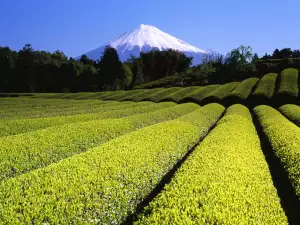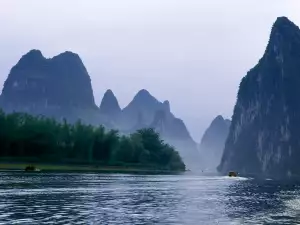The most beautiful natural attractions in Asia
Asia is the largest continent in area and it is not surprising that there are collected some of the most beautiful natural phenomena. You can go from the northern steppes and streamers and navigate to the tropical jungle on the banks of magnificent waterfalls. If you do not stop for too long, you can get to the beach and the Indian Ocean and the exotic Indonesian islands whose gentle climate keeps the mood good.Mount Fuji (Japan)
Fuji Mountain is the highest volcano in Japan, 3776 meters and is located west of Tokyo.

Tubbataha Reef (Philippines)
Australia has its Great Barrier Reef and the Philippines have their Tubbataha Reef. It is located in the Sulu Sea near the Palau. This is a wonderful place for diving and surprises fans of the oceanic flora and fauna with its wealth. Its area is 32,200 hectares and it has over 3 thousand plant and animal species that manages to preserve the ecological balance of the area.
Stone Forest (China)
Stone Forest in the Chinese province of Yunnan (in southwestern part of the country) is an area with high cliffs that rise from the ground like stalagmites. Some of them extend in height. This creates the illusion of majestic forests, particularly if in the morning in the foggy winter months. These cast formations are more than 270 million years and are shaped by erosion. You can get there from Kunming by train.
Guilin Karst (China)
Australia is proud of the monolithic rock formation Uluru, which is 350 meters high and has a circumference of 10 km, but a Chinese city has its Guylin pyramids and towers, many of which may resemble teeth. The magic landscape can be crossed by bus, helicopter or water.

Here they have found pottery from between 7 and 10 thousand years BC. The first settlement here was founded more than 2 thousand years ago during the reign of Kin Shi Huang, known for making statues of soldiers, called Clay warriors. He is the ruler, which creates channels Ling that is connecting the Pearl River Yangtze.
Cave Reed Flute
The name of this remarkable place, which is near the town of Guylin comes from reed stems, which grow nearby and that people use to produce flutes. Some rock formations have truly poetic names, "dragon pagoda", "virgin forest", "Fruits Mountain" and "Red Curtain" is just some examples. Most are illuminated with colored lights and it turns the visit into a real spectacle, which is complemented by the legends of any place.
Beppu ONSEN (Japan)
This is a hot spring that provides more water than any other country (140 thousand liters per day). It is located in the city in a place called’’Hell of Bepu’’. There are hot water springs from 200-300 m below ground, and the average temperature is 60 degrees Celsius.
Taroko National Park (Taiwan)
This is one of the most popular tourist attractions in Taiwan. This park is located within a 19 kilometer canyon, whose walls are made primarily of marble and granite. High cliffs, aged more than 200 million years, rapids and waterfalls add beauty to the surroundings. "Taroko" means "great". This gorge is also known for the specific nephritis, which can be found only here.
Huangshan Mountains (China)
In many Chinese papyrus you can see paintings of Huangshan mountain massif. Its beauty has inspired generations. Provocatively curved rocks and playful walks in the clouds become magic. Be sure to visit the light peak, the place where you can enjoy the sunrise.
Gobi Desert (Mongolia, China)
one of the largest deserts in the world is the Gobi. It covers most of southern Mongolia. The area is 1.3 million km2, temperatures are severe, the winds are fierce and sand, dust and rocks are everywhere. There are also oases and some animal species, especially well suited to these conditions, camels, gazelles and leopards and some birds, but most remain only on its periphery.
In the eastern desert plateau of Alashan and the dry valley lakes of the Gobi you can go to the Silk Road.
Mount Everest (Nepal)
The highest peak on earth is also a symbol of human aspiration to conquer the wild. It is 8848 meters high and was called by the locals. Sherpas Chomolungma, (Mother Goddess of the World). Interesting is that it dates back to the first half of the nineteenth century, but because of the rivalry of Nepal, Tibet and China in the region, shipments begin later and now are mostly only foreign initiatives
